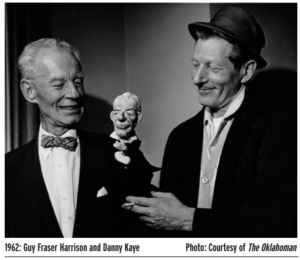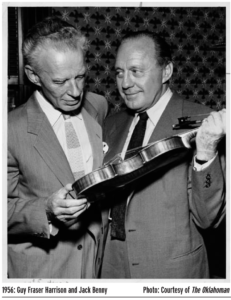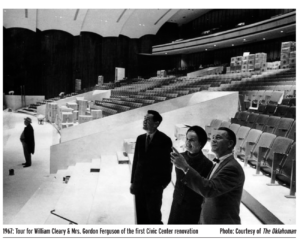Guy Fraser Harrison :: Music Director 1951 – 1973
The Symphony enjoyed a growing reputation throughout the 50s as a major cultural entity of the Southwest during the tenure of British-born Guy Fraser Harrison as music director and conductor. The 55-year old conductor was beloved for the development of outstanding programs for children and young people in Rochester, N.Y., where he had spent the previous 30 years of his career. His arrival in Oklahoma City heralded a series of firsts including Kinder Koncerts for preschoolers, Brown Baggers for the downtown lunch crowd and the Opening Doors program of performances in public schools throughout the state.
 Lean and tall with a shock of graying hair, Harrison had a quick smile and unbounded energy. He threw himself into every aspect of the organization from fundraising and education to public relations in addition to his primary responsibilities of conducting. From the first rehearsal, the new conductor was welcomed by the orchestra musicians who appreciated his precise baton technique and courtly demeanor. Harrison started a tradition that continues to the present day. At the beginning of every concert, he would stride briskly to the podium, with his face turned toward the audience he would give the downbeat for the national anthem and lead the orchestra and audience in the patriotic salute. His first concert as music director in Oklahoma City was October 23, 1951, and opened with the Prelude to “Die Meistersinger” by Wagner and featured the “Fantasia on a Theme by Thomas Tallis” by Vaughan Williams and the Symphony No. 2 by Johannes Brahms.
Lean and tall with a shock of graying hair, Harrison had a quick smile and unbounded energy. He threw himself into every aspect of the organization from fundraising and education to public relations in addition to his primary responsibilities of conducting. From the first rehearsal, the new conductor was welcomed by the orchestra musicians who appreciated his precise baton technique and courtly demeanor. Harrison started a tradition that continues to the present day. At the beginning of every concert, he would stride briskly to the podium, with his face turned toward the audience he would give the downbeat for the national anthem and lead the orchestra and audience in the patriotic salute. His first concert as music director in Oklahoma City was October 23, 1951, and opened with the Prelude to “Die Meistersinger” by Wagner and featured the “Fantasia on a Theme by Thomas Tallis” by Vaughan Williams and the Symphony No. 2 by Johannes Brahms.
The concert schedule for the 1952-53 season included 12 regular subscription concerts, plus 22 radio concerts, five Little Symphony programs, three Pops concerts and four children’s concerts. In addition, the symphony played its first ever television concert on WKY-TV with a program that included a suite from Tchaikovsky’s Nutcracker, Roman Carnival Overture by Hector Berlioz, Debussy’s Claire de lune, Rimsky-Korsakov’s Capriccio Espagnole and Haban by American composer Morton Gould.
 The 12 regular subscription concerts announced for the season was half the number presented the previous year and concerned musicians were told that the cost cutting measure would ensure a balanced budget for the season since it reduced expenses by more than $22,000. Despite having more than 4,500 season subscribers, the organization had once again built up a deficit. The programming cut was made due to concerns about $47,000 of current debt and the board did not want to add to the problem. Despite solid attendance at most concerts, the fundraising efforts were coming up short on a regular basis.
The 12 regular subscription concerts announced for the season was half the number presented the previous year and concerned musicians were told that the cost cutting measure would ensure a balanced budget for the season since it reduced expenses by more than $22,000. Despite having more than 4,500 season subscribers, the organization had once again built up a deficit. The programming cut was made due to concerns about $47,000 of current debt and the board did not want to add to the problem. Despite solid attendance at most concerts, the fundraising efforts were coming up short on a regular basis.
The Women’s Committee was hard at work throughout these years as the membership did everything from fundraising, program ad sales and ticket sales to office work and artist hospitality. Founding president of the group, Mrs. Gordon Ferguson, always stressed the purpose of the Women’s Committee was to stimulate interest in classical music and they began to organize the radio project, children’s concerts and classes in music appreciation.
The quality of music making continued to mature under Guy Fraser Harrison. During a regular season, the orchestra performed as many as 80 concerts and the season expanded to 24 weeks by the 1960-61 Season. The broadcasts continued with 20 performances heard around the world. The board of directors also invested in a new concert shell for the stage at the Municipal Auditorium. The Women’s Committee was successfully producing the “Great Artist Series,” presenting extraordinary performers of the time in popular recitals. In addition, the orchestra presented a “Little Symphony” series in the Hall of Mirrors that offered chamber and small orchestra works with local soloists. Further, orchestra concerts were presented regularly in 10 cities around Oklahoma each season and in dozens of elementary and high schools around the region.
 Once again, the financial demands of the expanding orchestra were beginning overwhelm the board and management of the orchestra as an “S.O.S.” (Save Our Symphony) group was formed in the summer of 1961 to take over the primary fundraising from the Women’s Committee. Interest in the broadcast concerts slumped and they were concluded at the end of the 1963-64 Season. Throughout the 60s, the increasing need for contributed income is reflected in the rising goals of each annual sustaining fund. As the goals rose from $100,000 to $130,000 to $150,000 in 1969, civic leaders came forward to direct hundreds of dedicated volunteers who canvassed the city for both ticket buyers and donors. The lists of contributors grew throughout the decade and each campaign, though challenging, was successful.
Once again, the financial demands of the expanding orchestra were beginning overwhelm the board and management of the orchestra as an “S.O.S.” (Save Our Symphony) group was formed in the summer of 1961 to take over the primary fundraising from the Women’s Committee. Interest in the broadcast concerts slumped and they were concluded at the end of the 1963-64 Season. Throughout the 60s, the increasing need for contributed income is reflected in the rising goals of each annual sustaining fund. As the goals rose from $100,000 to $130,000 to $150,000 in 1969, civic leaders came forward to direct hundreds of dedicated volunteers who canvassed the city for both ticket buyers and donors. The lists of contributors grew throughout the decade and each campaign, though challenging, was successful.
 The sixties were a time of growth in the arts in Oklahoma City with the founding of the City Civic Ballet, Canterbury Choral Society, Lyric Theatre, a short-lived Oklahoma City Opera, the Festival of the Arts, repertory theaters and the renovation of the Municipal Auditorium into the Civic Center Music Hall. A cavalcade of acclaimed soloists and ensembles performed regularly in town including Van Cliburn, Arthur Fiedler, Byron Janis, Isaac Stern, Misha Dichter, Gina Bachauer and many others. The Symphony had expanded to offering pairs of performances for each concert and Ray Luke joined the conducting staff in 1968 as associate conductor.
The sixties were a time of growth in the arts in Oklahoma City with the founding of the City Civic Ballet, Canterbury Choral Society, Lyric Theatre, a short-lived Oklahoma City Opera, the Festival of the Arts, repertory theaters and the renovation of the Municipal Auditorium into the Civic Center Music Hall. A cavalcade of acclaimed soloists and ensembles performed regularly in town including Van Cliburn, Arthur Fiedler, Byron Janis, Isaac Stern, Misha Dichter, Gina Bachauer and many others. The Symphony had expanded to offering pairs of performances for each concert and Ray Luke joined the conducting staff in 1968 as associate conductor.













